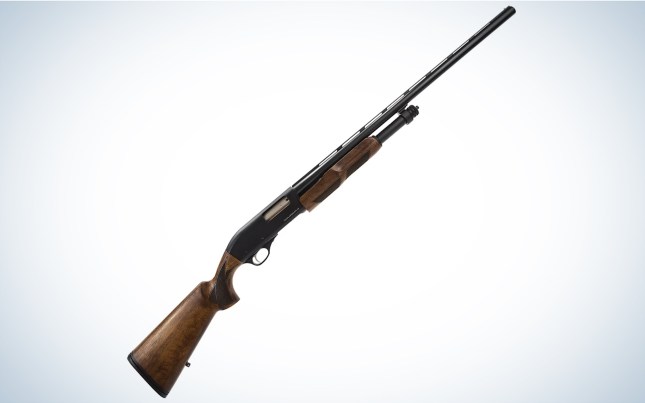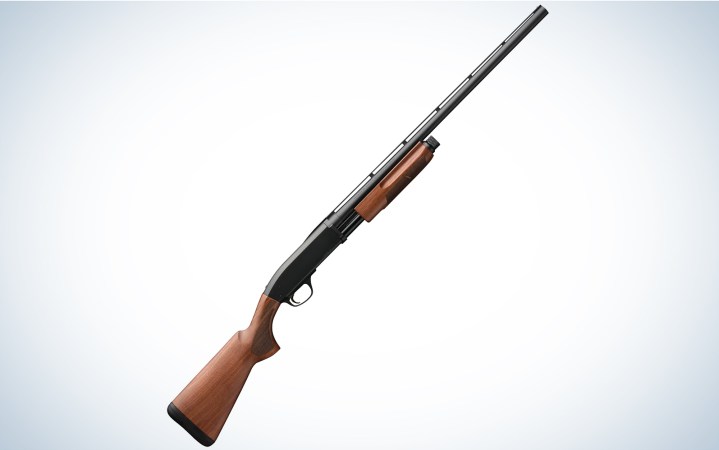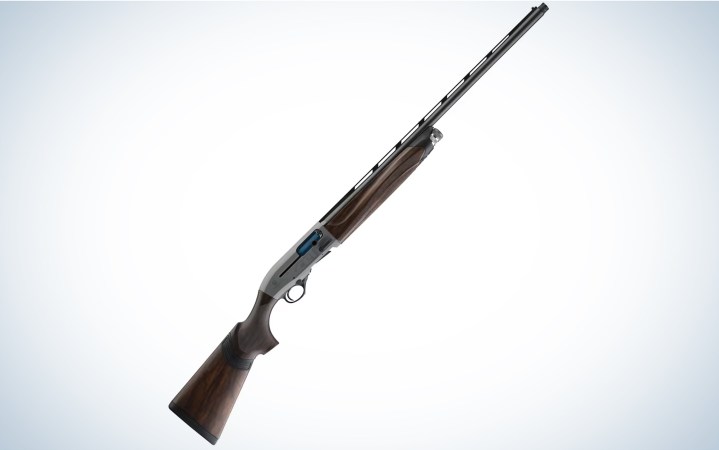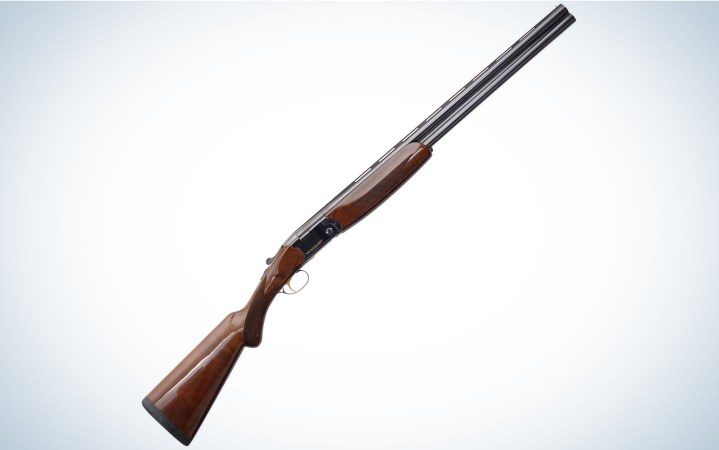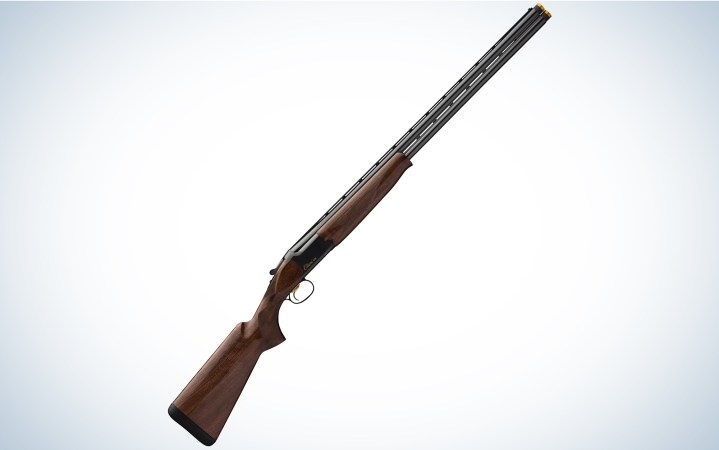We may earn revenue from the products available on this page and participate in affiliate programs. Learn More ›
Sporting clays is the most challenging of the shotgun sports. It’s also become one of the most popular because, well, it’s fun. Also, every sporting clays course is unique, unlike American skeet and trap, which is the same at any range. Sporting clays gives you the opportunity to attempt a variety of difficult shots that require good form and shooting instincts as opposed to the muscle memory you need to excel at skeet or trap.
Although you will see many professionals shoot high-priced over/unders on sporting clays, the casual shooter doesn’t need to spend tens of thousands of dollars to find their own best shotgun for sporting clays. For instance, if you are a wingshooter, your duck or pheasant gun (properly choked) is likely ideal for sporting clays.
If you are thinking about getting into sporting clays, a hunter who wants to sharpen your shooting skills, or an advanced target shooter looking to upgrade, here are three shotguns designed specifically for sporting clays for beginners, intermediate, and experienced shooters.
Best Pump Shotguns for Sporting Clays Beginners
Best Semi-Auto Shotguns for Sporting Clays
Best Over/Under Shotguns for Sporting Clays
How We Picked the Best Shotguns for Sporting Clays
If price were no option, the very best shotguns for sporting clays cost north of $10,000. But if you’re a beginner to intermediate shooter who’s looking to up your game, all of the guns on this list present a good value. Prices range from less than $400 to $7,500. Many of the guns on the list make for excellent crossover guns that will work well for sporting clays and hunting. All combined, the authors of this story have decades of shooting and hunting experience and we’ve shot all of the guns included here.
Shotgun Platforms for Sporting Clays
Since you will need a gun that holds at least two shells to shoot sporting clays, single-shot guns are out. That leaves over/unders, side-by-sides, pumps, and auto-loaders as suitable sporting clays firearms.
Over/Unders for Sporting Clays
Over/unders are the most popular style of sporting clays shotgun among those who want to purchase a shotgun specifically dedicated to this pursuit. Over/unders come in a wide range of price points. A serviceable double starts around $1,000 and the high-end break-actions will cost north of $30,000.
Over/unders generally break clays better if you buy one that has been built for clay shooting. This is because over/under stocks are more likely to be cast dependent on what hand you shoot with. Right-handers will have more cast on the right side of the stock, and vice-versa for lefties. Most over/unders have longer barrels—from 28 inches up to 34 inches—which makes for a smoother, balanced swing on clays. Some doubles will also have ported barrels to tame recoil and make it easier to get on the second clay bird.
Semi-Auto Shotguns for Sporting Clays
Auto-loaders remain a sporting clays favorite. Even some professionals shoot them as opposed to the more popular over/unders. Beretta’s gas-operated models are shooter favorites because they fit a variety of different body types and pattern evenly. Many women and youth shooters enjoy shooting the early 300 series Berettas, which is proof they have a remarkable fit as they were not designed for women or teenagers, but both generally shoot them well.
Gas-operated semi-autos have the added benefit of dampening recoil, making them extremely comfortable to shoot. They are not overly expensive, and if well maintained, will provide reliable service. The downside of gas-operated autoloaders is that they get dirty, particularly with cheap ammo. This means a regimented gun cleaning is necessary to avoid a shell hanging up in the action when you’re trying to break the second clay.
Pump Shotguns for Sporting Clays
Pumps are reliable, but you also must work the action manually to load a second shell and then get the gun on a speeding clay. But in this shooting discipline, you often have the time to pump the gun and crush the second target. There will be some stations that are more demanding and require a quick second shot, but if you can break doubles on skeet with a pump gun, you can do the same on sporting clays.
Best Pump Shotguns for Sporting Clays Beginners
CZ-USA 612 Field
CZ-USA 612 Field
Key Features
- Gauge: 12
- Action: Pump
- Capacity: 4+1
- Chamber: 3-inch
- Barrel Length: 28-inch
- Chokes: C, M, F
- Front Sight: White bead
- LOP: 14.5 inches
- Overall Weight: 6.2 pounds
- MSRP: $399
Pros
- Reliable and inexpensive
Cons
- Turkish-made shotgun
I’m a serious clays shooter, but if I were just starting out and wanted a mechanically reliable, yet relatively inexpensive shotgun, I would select a CZ-USA 612 Field. The 612 runs superbly on the sporting clays field. I’ve shot one, and it’s a fine-pointing clays gun. I wouldn’t hesitate to carry it while tromping through pheasant fields or sitting in a duck boat blind. These guns look nice, shoot well, and are mechanically bulletproof. The simplicity of a pump-action gun means there’s very little that can go wrong. It can get dirty and wet and still operate to its potential.
The 612 Field features a 28-inch barrel with ventilated rib, which along with the added action length of the pump gun receiver, brings the overall length to 49 inches, which is about as short of a sporting clays gun as you want to use if you’re an adult male shooter. Available in 12-gauge, it features three removable choke tubes and a 3-inch chamber. This is a no-frills gun that should last several generations if properly cared for. It’s a versatile gun as well. You can shoot clays and hunt any bird species with it. And it costs under $400. —Dana Farrell
Remington FieldMaster
Key Features
- Gauge: 20, 12
- Action: Pump
- Capacity: 4+1
- Chamber: 3½-inch, 3-inch
- Barrel Length: 28-, 26-inch
- Chokes: IC, M, F
- LOP: 14 inches
- Overall Weight: 7.4 pounds
- MSRP: $600
Pros
- Very durable and an upgrade from the Express.
Cons
- RemArms is still a new company, so it’s too early to say what the future holds for their firearms.
RemArms, the company that now owns Remington shotguns, rifles, and handguns, discontinued the 870 Express last year in favor of the 870 Fieldmaster. The Fieldmaster is an upgrade over the Express and has proved to be an incredibly reliable firearm too. I torture tested the Fieldmaster in 2022, and the only way I was able to get the 3-inch gun to fail was by caking the inside of the action with a dirt clod and then completely submerging the gun in my family’s fishing pond. But with a quick field strip and wipe down, I was back to shooting.
The Fieldmaster comes with three chokes (IC, M, and F), so you have more options when shooting clays—the Express only came with a modified choke. Since the torture test, I have shot the Fieldmaster on skeet with no choke with fantastic results. Most shotgun manufacturers will warn against shooting chokeless, because it could damage the threads but I have never had an issue doing this with any of my shotguns. The action bars have a smooth metal finish to make pumping the 870 plenty slick, critical when you are shooting doubles. There is also a soft recoil pad affixed to the buttstock to dampen recoil. The stock and fore-end are American walnut and the steel receiver and barrel (26- or 28-inch options) are finished with a rust-resistant coating. —Joe Genzel
Browning BPS Field
Browning BPS Field
Key Features
- Gauge: 12, 20, 28, .410
- Action: Pump
- Capacity: 4+1
- Chamber: 3-inch
- Barrel Length: 28-, 26-inch
- Chokes: IC, M, F
- LOP: 14¼ inches
- Overall Weight: 7.10 pounds
- MSRP: $800
Pros
- Hefty overall weight makes the BPS easier to swing through the target
- Good option for lefties
Cons
- On the more expensive side for a pump shotgun.
In the last decade many gun manufacturers have been making clays guns lighter, specifically auto-loaders. The Browning BPS Field, however, weighs nearly 8 pounds. Though this may sound counterintuitive, heavier, well-balanced guns are easier to keep swinging through the target than light ones. It’s harder to stop a gun that weighs 8 pounds versus one that weighs less than 7. The BPS Field is available in every gauge but 10 and 16 (there is a 10-gauge Field Composite variant) with blued 26- or 28-inch barrels. It has a tang-mounted safety, which is more convenient and accessible for lefties than a trigger group-mounted safety.
Reloaders (and your trap shooting partners) will love the bottom-eject feature of the BPS. Instead of sending a spent hull off the course, it falls at your feet. You don’t have to go around searching for hulls to reload. Browning paired the Invector-Plus choke system (IC, M, and F) with the BPS. That reliable set of tubes that has been a mainstay of the Citiori. There is a thick recoil pad at the end of the buttstock, and the fore-end has grooves on either side of it to place your hand to make pumping the shotgun smooth. —J.G.
Best Semi-Auto Shotguns for Sporting Clays
Franchi Affinity 3 Sporting
Franchi Affinity 3 Sporting
Key Features
- Gauge: 12, 20
- Action: Semi-auto, inertia
- Capacity: 4+1
- Chamber: 3-inch
- Barrel Length: 28-, 30-inches
- Chokes: IC, M, F
- LOP: 14.5 inches
- Overall Weight: 7.1 pounds (12 gauge)
- MSRP: $1,129
Pros
- Reliable semi-auto at a fair price
Cons
- Does not include as many features as top-end guns
The Franchi Affinity 3 Sporting is probably the best shotgun for sporting clays you’ll find at this price point. The Affinity 3 series is well-regarded as reliable, affordable, and sweet shooting, and their sporting version is no exception. The gun operates on an inertia driven action that’s similar to those found in Benelli shotguns—Franchi’s sister company. The minimum recommended load for the 12 gauge version of this gun is 3 dram, 1 ⅛ ounce loads, so you’ll have to keep an eye on that when selecting target ammo. Otherwise, this gun has some nice adjustability options with shims for cast and drop so you can get the gun hitting where you want it. It also comes with a cushy TSA recoil pad. —Alex Robinson
Beretta A400 Xcel Sporting
Beretta A400 Xcel Sporting
Key Features
- Gauge: 12, 20
- Action: Semi-auto, gas
- Capacity: 2+1
- Chamber: 3-inch
- Barrel Length: 28-, 30-inches, 32-inches
- Chokes: C, M, F
- LOP: 14.25 inches
- Overall Weight: 7 pounds, 7 ounces
- MSRP: $2,219
Pros
- Feature packed
- Light recoil
Cons
- Gas guns tend to get dirty faster
I’m a long-time Beretta loyalist. Their shotguns are reliable, and most shooters shoot them well. Some of the best sporting clays shooters in the world rely on them, like Scott Robertson or Joseph Fanizzi.
Beretta has a long lineage of auto-loaders, the most recent of which is the A400. The A400 replaced the ever-popular 391 platform, which in turn replaced the 390.
Ask any reputable sporting clays instructor and he or she will tell you an auto is a good way to go when starting to get serious about the clays game. They’re not too expensive, and customized parts are readily available, allowing you to balance and adjust the gun to your liking and shooting style.
The Beretta A400 comes in close to 20 model variations, but for the sake of this article we’ll stick with the A400 Xcel Sporting. This latest model replaces the “Xcel” which you’ll still see on many clays courses. You can’t miss it with its blue receiver.
The gas-operated A400 is available with either a 28-, 30-, or 32-inch barrel. The MSRP is $2,219 and the gun comes with all sorts of cool features like enlarged controls, Blink gas operating system, and Beretta’s Kick-Off recoil reduction system. Altogether, these features make for a soft-shooting, fast-cycling semi-auto. If you’re a hunter, the A400 Xtreme Plus is the best option for you. That gun won our review of the best duck hunting shotguns, and it’s plenty capable on a clays course. —D.F.
Best Over/Under Shotguns for Sporting Clays
Weatherby Orion
Key Features
- Gauge: 12, 20
- Action: Boxlock over/under
- Capacity: 2
- Chamber: 3-inch
- Barrel Length: 28-, 26-inch
- Chokes: IC, M, F
- LOP: 14 inches
- Overall Weight: 7 pounds
- MSRP: $1,049
Pros
- Should be able to find at least $100 less than MSRP
Cons
- Should purchase aftermarket chokes
Weatherby’s shotguns are often an afterthought because the company is most well-known for making bolt-action rifles. But the Orion has been a mainstay in the Wyoming gunmaker’s lineup since the early 1980s. The Orion was first built to Weatherby’s specifications by SKB in Japan, then Fausti, and now ATA, a Turkish manufacturer. It’s not an ornate over/under—the metal finishes are blued and there is no scroll work on the receiver—but the wood-to-steel transitions are seamless. A boxlock break-action, the Orion has automatic ejectors and a selectable safety. The checkered Prince of Wales stock is more rounded than a pistol grip or straight English-style stock. A stepped rib 26- or 28-inch barrel leads to a single brass bead at the muzzle. The sidewalls of the barrel are vented to take weight out of the gun (the 12-gauge is 7 pounds and the 20 weighs 6.2 pounds).
You get three chokes (IC, M, and F) with the Orion, though it would be nice to have a cylinder and light modified choke included. Because they have two barrels, over/unders present the unique opportunity to shoot two different patterns from the same gun without the annoyance of removing and inserting different chokes. This is useful on a sporting clays range because you’ll be dealing with different target presentations at a variety of ranges. However, you can’t take full advantage of the Orion’s patterning capabilities without a full range of choke tubes. But still, this is a gorgeous over/under for less than $1,000 and there are plenty of aftermarket chokes at your disposal. —J.G.
Browning Citori CXS
Browning Citori CXS
Key Features
- Gauge: 12, 20
- Action: over/under
- Capacity: 2
- Chamber: 3-inch
- Barrel Length: 28-, 30-, 32-inch
- Chokes: F, M, IC
- LOP: 14.75 inches
- Overall Weight: 7 pounds, 10 ounces (28-inch barrel)
- MSRP: $2,530
Pros
- Capable on the clays course and in the field
Cons
- Not a true competition gun
The Browning Citori line celebrates its 50th anniversary in 2023 to the delight of gold trigger fans everywhere. There are a ton of different Citori models, and the CXS version is what Browning describes as a crossover clays-hunting gun (hence the “X” in the name). Here’s the bad news first: The CXS is a little heavy for a dedicated upland bird hunting gun and it doesn’t have all the features of a true competition gun. But as with any crossover, you have to give up a little specialization in order to gain versatility.

A few years ago, I wanted a gun that I could practice with seriously on the sporting clays course and then hunt with in the fall. For this purpose, the CXS is perfect. Sometimes I don’t mind carrying a heavier shotgun when pheasant hunting, but I do mind missing roosters. The weight and balance of the CXS is perfect for my tastes; it’s balanced right in the middle and weighs under eight pounds (I’d stick with the 28-inch barrels if you intend to hunt with yours). The fact that I shoot it on clays during the summer helps me avoid making an awkward mount and bad shot on that first rooster of opening day.
The gun has some nice features, including: Invector-Plus Midas grade extended choke tubes, triple trigger system (which allows you to adjust length of pull by sliding the trigger forward or back), a mid bead, moderate palm swell, hammer ejectors, and Inflex recoil pad. The stock is a handsome Grade II American walnut (so not too fancy that you feel bad about abusing it in the field).
There’s not much in terms of adjustability, but the gun fit me well out of the box and comes to my shoulder quickly. That’s helped me kill plenty of roosters, and crush clay targets, too. —A.R.
Zoli Z-Sport
Zoli Z-Sport
Key Features
- Gauge: 12, 20, 28
- Action: over/under
- Capacity: 2
- Chamber: 3-inch
- Barrel Length: 28-, 30-, 32-, 34-inch
- Chokes: IM, LM, Mod, IC, C/SK, Skeet 2
- LOP: 14.5 inches
- Overall Weight: 8 pounds, 7 ounces (32-inch barrel)
- MSRP: $7,500
Pros
- Incorporates many features of a top-end clays gun at a lower price point
Cons
- None
You can spend what it costs to buy a new car on a pricey over/under shotgun. But for most of us, there’s honestly no reason to throw down more than $10,000 even if you are a dedicated shooter. That’s why I love the Zoli Z-Sport, which starts at $7,500. Available in 12-gauge with barrel lengths of 28, 30, 32, and 34 inches, this Italian-made shotgun is an ideal choice for shooters looking for an affordable high-end sporting clays shotgun.
The Z-Sport is available in a flat, mid-height and adjustable height rib models. All Zoli over/unders feature actions, trigger plates, and monoblocs built on forged steel, plus removable trigger groups. An optional BHB system allows you to fine tune the balance of the gun using incremental weights placed under the fore-end and in the grip. This is a gun that truly stands with the best of the best in terms of mechanical integrity and aesthetic appeal. —D.F.
How to Choose the Best Shotguns for Sporting Clays
Gun fit is the most critical component of picking the right sporting clays shotgun. You’re shooting at small targets that are typically moving faster than live birds during a hunt, so there’s less margin for error. That said, it’s difficult to be sure a gun off the rack properly fits. You should start by going to a trusted gun dealer with a knowledgeable shooter behind the counter. Also, many shooting ranges will have days set aside for manufacturers to allow any shooter to test their guns on skeet, trap, or sporting clays. Call your local range and find out if there are any such events scheduled and if the shotgun maker is sending someone to represent their company. That person should be able to fit their firearm to you and give you an idea of the ideal length of pull, cast, and drop for your shooting style and body type.
If you’re buying a shotgun off the rack, one trick I use is to mount the unloaded gun—pointed in a safe direction—with my eyes closed. Once I am comfortable with the position of the gun, I open my eyes. If my dominant eye is looking straight down the rib, that’s a good sign. You can also mount the gun and look into a mirror to see where your eye is aligned. If it’s not straight down the rib, then there is likely an issue with the cast of the stock. It’s also a good idea to bring along a gun that you shoot well and one that you don’t. This will help a competent sales person or gunsmith understand what gun fits you best.
Why Trust Outdoor Life?
Since 1898, OL has been a leading authority in testing and reviewing hunting gear, fishing tackle, guns and shooting equipment, and much more. We have more than a century-long history of evaluating products, and we’re now bringing that expertise to online reviews. Our editors are experienced outdoorsmen and women, and most importantly, we’re trained journalists. We prioritize field testing and objective data when reviewing products. We conduct interviews with gear manufacturers and engineers as well as outdoor experts so that our readers have an understanding of how and why a product works—or doesn’t.
Advertising does not influence our gear reviews and it never will. While we always focus our coverage on standout products—because we want our readers to be aware of the latest and greatest gear—we also cover the flaws and quirks of any given product.
Final Thoughts on the Best Shotguns for Sporting Clays
The best sporting clays gun for you is the one that fits you and your budget well. You don’t need to spend a fortune in order to shoot high scores. You just need practice. Most of the sporting clays shooters I know shoot in order to sharpen their skills for hunting season (and because it’s fun). So, it makes sense that most field guns will perform just fine on the clays course. However, if you are pursuing sporting clays as your primary passion, it’s wise to go with a high-end gun that can be easily adjusted to fit you precisely.
Best Pump Shotguns for Sporting Clays Beginners
Best Semi-Auto Shotguns for Sporting Clays
Best Over/Under Shotguns for Sporting Clays

